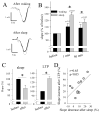Electrophysiological correlates of sleep homeostasis in freely behaving rats
- PMID: 21854953
- PMCID: PMC3160719
- DOI: 10.1016/B978-0-444-53839-0.00002-8
Electrophysiological correlates of sleep homeostasis in freely behaving rats
Abstract
The electrical activity of the brain does not only reflect the current level of arousal, ongoing behavior, or involvement in a specific task but is also influenced by what kind of activity, and how much sleep and waking occurred before. The best marker of sleep-wake history is the electroencephalogram (EEG) spectral power in slow frequencies (slow-wave activity, 0.5-4 Hz, SWA) during sleep, which is high after extended wakefulness and low after consolidated sleep. While sleep homeostasis has been well characterized in various species and experimental paradigms, the specific mechanisms underlying homeostatic changes in brain activity or their functional significance remain poorly understood. However, several recent studies in humans, rats, and computer simulations shed light on the cortical mechanisms underlying sleep regulation. First, it was found that the homeostatic changes in SWA can be fully accounted for by the variations in amplitude and slope of EEG slow waves, which are in turn determined by the efficacy of corticocortical connectivity. Specifically, the slopes of sleep slow waves were steeper in early sleep compared to late sleep. Second, the slope of cortical evoked potentials, which is an established marker of synaptic strength, was steeper after waking, and decreased after sleep. Further, cortical long-term potentiation (LTP) was partially occluded if it was induced after a period of waking, but it could again be fully expressed after sleep. Finally, multiunit activity recordings during sleep revealed that cortical neurons fired more synchronously after waking, and less so after a period of consolidated sleep. The decline of all these electrophysiological measures-the slopes of slow waves and evoked potentials and neuronal synchrony-during sleep correlated with the decline of the traditional marker of sleep homeostasis, EEG SWA. Taken together, these data suggest that homeostatic changes in sleep EEG are the result of altered neuronal firing and synchrony, which in turn arise from changes in functional neuronal connectivity.
Copyright © 2011 Elsevier B.V. All rights reserved.
Figures






Similar articles
-
Sleep homeostasis and cortical synchronization: I. Modeling the effects of synaptic strength on sleep slow waves.Sleep. 2007 Dec;30(12):1617-30. doi: 10.1093/sleep/30.12.1617. Sleep. 2007. PMID: 18246972 Free PMC article.
-
Sleep homeostasis and cortical synchronization: III. A high-density EEG study of sleep slow waves in humans.Sleep. 2007 Dec;30(12):1643-57. doi: 10.1093/sleep/30.12.1643. Sleep. 2007. PMID: 18246974 Free PMC article.
-
Why Does Sleep Slow-Wave Activity Increase After Extended Wake? Assessing the Effects of Increased Cortical Firing During Wake and Sleep.J Neurosci. 2016 Dec 7;36(49):12436-12447. doi: 10.1523/JNEUROSCI.1614-16.2016. J Neurosci. 2016. PMID: 27927960 Free PMC article.
-
Synaptic potentiation and sleep need: clues from molecular and electrophysiological studies.Curr Top Med Chem. 2011;11(19):2472-82. doi: 10.2174/156802611797470312. Curr Top Med Chem. 2011. PMID: 21906017 Review.
-
Developmental aspects of sleep slow waves: linking sleep, brain maturation and behavior.Prog Brain Res. 2011;193:63-82. doi: 10.1016/B978-0-444-53839-0.00005-3. Prog Brain Res. 2011. PMID: 21854956 Review.
Cited by
-
The temporal structure of behaviour and sleep homeostasis.PLoS One. 2012;7(12):e50677. doi: 10.1371/journal.pone.0050677. Epub 2012 Dec 5. PLoS One. 2012. PMID: 23227197 Free PMC article.
-
Functional states shape the spatiotemporal representation of local and cortex-wide neural activity in mouse sensory cortex.J Neurophysiol. 2022 Oct 1;128(4):763-777. doi: 10.1152/jn.00424.2021. Epub 2022 Aug 17. J Neurophysiol. 2022. PMID: 35975935 Free PMC article.
-
Developmental alcohol exposure is exhausting: Sleep and the enduring consequences of alcohol exposure during development.Neurosci Biobehav Rev. 2024 Mar;158:105567. doi: 10.1016/j.neubiorev.2024.105567. Epub 2024 Feb 1. Neurosci Biobehav Rev. 2024. PMID: 38309498 Free PMC article. Review.
-
Rapid fast-delta decay following prolonged wakefulness marks a phase of wake-inertia in NREM sleep.Nat Commun. 2020 Jun 19;11(1):3130. doi: 10.1038/s41467-020-16915-0. Nat Commun. 2020. PMID: 32561733 Free PMC article.
-
Homeostatic NREM sleep and salience network function in adult mice exposed to ethanol during development.Front Neurosci. 2023 Nov 14;17:1267542. doi: 10.3389/fnins.2023.1267542. eCollection 2023. Front Neurosci. 2023. PMID: 38033546 Free PMC article.
References
-
- Achermann P, Borbely AA. Low-frequency (< 1 Hz) oscillations in the human sleep electroencephalogram. Neuroscience. 1997;81:213–222. - PubMed
-
- Achermann P, Borbely AA. Temporal evolution of coherence and power in the human sleep electroencephalogram. J Sleep Res. 1998;7(Suppl 1):36–41. - PubMed
-
- Aizenman CD, Kirkwood A, Bear MF. A current source density analysis of evoked responses in slices of adult rat visual cortex: implications for the regulation of long-term potentiation. Cereb Cortex. 1996;6:751–758. - PubMed
-
- Alger BE, Teyler TJ. Long-term and short-term plasticity in the CA1, CA3, and dentate regions of the rat hippocampal slice. Brain Res. 1976;110:463–480. - PubMed
Publication types
MeSH terms
Grants and funding
LinkOut - more resources
Full Text Sources

